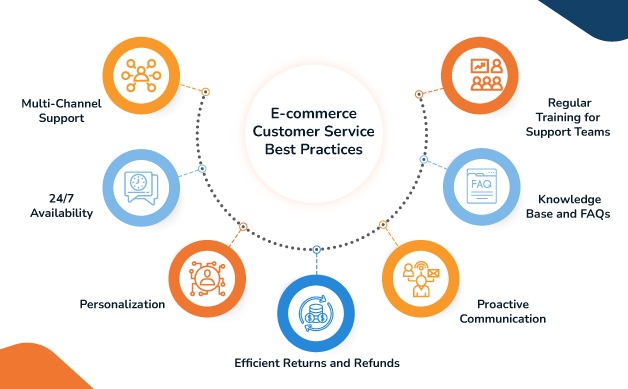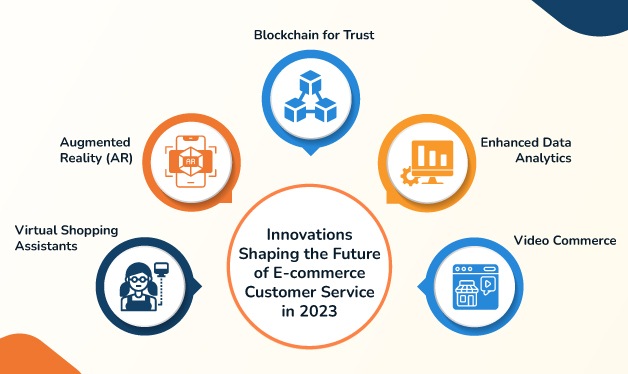E-commerce Customer Service – A Guide 2023
In the ever-evolving e-commerce landscape, customer service has emerged as a cornerstone for success. As we step into 2023, the role of customer support for e-commerce businesses becomes even more critical. In this comprehensive guide, we will explore e-commerce customer service best practices and explore strategies to improve customer service in e-commerce.
The Significance of Customer Support for E-commerce
In 2022, we witnessed a surge in e-commerce, with more businesses transitioning to online platforms. This trend has only accelerated in 2023. As a result, the competition in the e-commerce space has become fiercer, making excellent customer service a vital differentiator.
Customer Expectations Are Soaring
Modern consumers are not just looking for products; they demand seamless experiences. They expect quick responses, personalized interactions, and hassle-free returns. To meet such expectations, businesses must invest in their customer support systems.
Impact on Brand Loyalty
Exceptional customer service can create strong brand loyalty. According to a report by Forbes, 68% of customers leave a brand due to poor customer service. Conversely, satisfied customers are likely to become repeat buyers and brand advocates.
E-commerce Customer Service Best Practices

1. Multi-Channel Support
E-commerce businesses should be accessible through various channels like email, chat, social media, and phone. This ensures customers can reach out through their preferred method, enhancing convenience.
2. 24/7 Availability
In the digital age, customers shop at all hours. Offering 24/7 customer support, even through chatbots during off-hours, can be a game-changer.
3. Personalization
Personalize interactions by addressing customers by name and offering product recommendations based on their purchase history. It shows that you value their patronage.
Efficient Returns and Refunds
Streamline your returns and refund processes. Make it hassle-free for customers to return items they are not satisfied with, and ensure timely refunds.
Proactive Communication
Keep customers informed about order status, shipping delays, and product availability. Proactive communication minimizes uncertainty and reduces customer frustration.
Knowledge Base and FAQs
Maintain an informative knowledge base and FAQs section on your website. This empowers customers to find answers to common questions, reducing support ticket volume.
Regular Training for Support Teams
Invest in training your customer support team. Equip them with the knowledge and skills to handle customer inquiries effectively and professionally.
How to Improve Customer Service in E-commerce
Leverage Technology
1. AI-Powered Chatbots
Implement AI-powered chatbots for instant responses to common queries. These bots can also assist with order tracking and basic troubleshooting.
2. CRM Systems
Utilize Customer Relationship Management (CRM) systems to track customer interactions and preferences. This data helps in providing personalized service.
Collect and Analyze Customer Feedback
1. Surveys and Reviews
Encourage customers to provide feedback through surveys and reviews. Analyze this data to identify areas for improvement.
2. Net Promoter Score (NPS)
Use NPS surveys to gauge customer loyalty and satisfaction. It provides valuable insights into how your customers perceive your brand.
Prioritize Speed and Efficiency
1. Quick Response Times
Set benchmarks for response times and ensure that customer inquiries are addressed promptly.
2. Streamlined Processes
Continuously optimize your customer support processes to reduce resolution times and improve efficiency.
Cultivate a Customer-Centric Culture
1. Employee Training
Train your employees to prioritize customer satisfaction. Emphasize empathy and problem-solving skills.
2. Customer Feedback Integration
Make customer feedback an integral part of your business strategy. Use it to drive improvements across all departments.
Innovations Shaping the Future of E-commerce Customer Service in 2023

The e-commerce landscape constantly evolves, driven by technological advancements and changing consumer expectations. In 2023, several exciting innovations are set to reshape how e-commerce businesses interact with their customers. Let’s elaborate on four key innovations: Virtual Shopping Assistants, Augmented Reality (AR), Blockchain for Trust, and Enhanced Data Analytics.
1. Virtual Shopping Assistants
Virtual Shopping Assistants are AI-powered digital entities that guide customers’ online shopping journey. These intelligent assistants provide personalized recommendations and answer customer queries in real time.
How Virtual Shopping Is Going To Revolutionize The Way We Shop?
Here’s a deeper look into this game-changing innovation:
A. Personalized Recommendations
Virtual Shopping Assistants leverage machine learning algorithms to analyze a customer’s browsing and purchase history. By understanding the customer’s preferences, these assistants can recommend products that align with their tastes and needs. This personalization enhances the overall shopping experience and increases the likelihood of conversions.
B. Real-time Interactions
One of the standout features of Virtual Shopping Assistants is their ability to engage with customers in real time. Customers can ask questions, seek advice, and receive instant responses through chatbots or live chat. This level of responsiveness mimics the experience of having an in-store salesperson and dramatically reduces friction in the buying process.
C. Enhanced Customer Engagement
Virtual Shopping Assistants are not limited to text-based interactions; some incorporate voice and visual components. This versatility allows businesses to engage with a broader audience, including those who prefer voice commands or visual demonstrations.
D. Cost-efficiency and Scalability
For businesses, Virtual Shopping Assistants offer a cost-effective way to provide customer support. They can handle multiple customer inquiries simultaneously, reducing the need for extensive human customer service teams. As a result, businesses can scale their operations efficiently while still delivering high-quality support.
2. Augmented Reality (AR)
Augmented Reality (AR) is another groundbreaking innovation poised to revolutionize e-commerce in 2023. AR technology lets customers visualize products in their environment before purchasing, significantly reducing the likelihood of returns.
A. Immersive Shopping Experiences
AR allows customers to “try before they buy” in a virtual sense. For example, a customer interested in buying furniture can use AR to place a virtual couch in their living room to see how it fits and complements their existing decor. This immersive experience not only enhances customer confidence but also drives engagement.
B. Reducing Returns
One of the biggest challenges in e-commerce is managing returns. AR can help mitigate this issue by providing a more accurate representation of products. Customers who see how a product will look and fit in their real-life surroundings are less likely to return it due to unmet expectations.
C. Increased Conversion Rates
AR has been shown to boost conversion rates by providing a more interactive and engaging shopping experience. Customers are more likely to purchase when they have a clearer understanding of what they are buying.
D. Customization and Personalization
AR can also be used for customization and personalization. For example, customers can use AR to preview personalized engraving on jewelry or select custom color options for products. This level of personalization adds a unique touch to the shopping experience.
3. Blockchain for Trust
Blockchain technology is gaining traction in e-commerce to enhance transaction trust. In 2023, blockchain is expected to be pivotal in ensuring product authenticity and secure payments.
A. Supply Chain Transparency
Blockchain allows for creating transparent and tamper-proof ledgers of a product’s journey from manufacturer to customer. Customers can trace the origin of products, ensuring they are genuine and not counterfeit.
B. Secure Payments
Blockchain’s inherent security features make it ideal for secure online transactions. It eliminates the need for intermediaries, reducing the risk of fraud and providing customers with peace of mind when making purchases.
C. Smart Contracts
Smart contracts, powered by blockchain, can automate various aspects of e-commerce, such as order fulfillment and payment processing. This automation reduces administrative overhead and ensures that transactions are executed as agreed upon.
D. Customer Trust and Loyalty
When customers know they are dealing with a trustworthy and secure e-commerce platform, they are more likely to return for future purchases and recommend the venue to others. Blockchain can help build and maintain this trust.
4. Enhanced Data Analytics
In 2023, enhanced data analytics will continue to provide deeper insights into customer behavior, enabling businesses to offer hyper-personalized experiences.
A. Predictive Analytics
Advanced analytics tools can predict customer behavior and preferences based on historical data. Businesses can use this information to tailor their marketing strategies and product recommendations.
B. Customer Segmentation
Data analytics helps in creating precise customer segments. This allows businesses to target specific groups with personalized offers and content, increasing the chances of conversion.
C. Real-time Insights
Real-time data analytics provide businesses with up-to-the-minute information on customer interactions and transactions. This enables immediate responses to customer needs and issues.
D. Continuous Improvement
By analyzing customer feedback and behavior, businesses can identify areas for improvement in their products, services, and customer support. This iterative approach drives continuous enhancement and innovation.
5. Video Commerce
While the above innovations promise an exciting future for e-commerce, one trend gaining significant traction in 2023 is Video Commerce. Video commerce is revolutionizing the way e-commerce businesses interact with their customers.
How Video Commerce Is Reshaping the World of E-Commerce?
Video Commerce uses live streaming and recorded video content to showcase products, answer real-time customer questions, and create engaging shopping experiences. Here’s why it’s becoming a game-changer:
A. Enhanced Product Presentation
Videos allow customers to see products in action, providing a more comprehensive understanding of their features and benefits.
- Real-time Interaction – Live streaming enables real-time interaction between customers and hosts, allowing questions to be answered instantly.
- Building Trust – Video commerce humanizes the online shopping experience, helping build trust between the customer and the brand.
- Showcasing Expertise – E-commerce businesses can showcase their expertise through video content, positioning themselves as industry leaders.
Conclusion
In 2023, customer support for e-commerce has transcended its traditional role and become a strategic imperative. Businesses can meet and exceed customer expectations by implementing e-commerce customer service best practices and embracing innovative solutions. Remember, customer satisfaction isn’t just about solving problems; it’s about creating memorable experiences that foster brand loyalty and drive success in the competitive e-commerce landscape.










